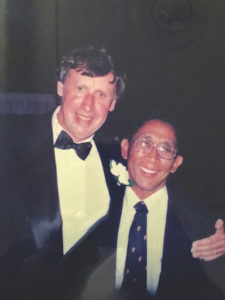During my early treks in the Himalaya, I quickly came to appreciate that Sherpas are exceptional people.
Years later, recalling our adventures together in the Khumbu, Jimmy Carter said to me, “I have never met any people as admirable in their friendship, their unselfishness, and their eagerness to do what is right than the Sherpas who helped us in the Himalayan region.”
Generosity and kindness are revered in their Buddhist tradition—essential conduct for ever-higher rebirth on the spiritual journey toward nirvana. The sacred nature of these traits no doubt is closely linked to, and magnified by, the harsh conditions of the high mountains.
Namche Bazaar, an ancient trading center, is the hub of Khumbu. Four decades ago the tableau was rough and rustic. There were no hotels. Most people lived in little huts—sheds, really—with holes in the ceiling for smoke to rise from fires lighted daily for cooking and heat. Rooms were smoky. Tuberculosis was widespread. Food was scarce.
P.K., my Sherpa guide and friend, invited us to stay with him, his wife Namdu, and the four little girls who rounded out their family then.
 As I came to learn, P. K. was known among Khumbu villagers as ambitious, even a bit wily, when it came to latching on to foreign trekkers. Maybe that is why his little homestead was better than most. He was eager for the business at a time when Western visitors were rare.
As I came to learn, P. K. was known among Khumbu villagers as ambitious, even a bit wily, when it came to latching on to foreign trekkers. Maybe that is why his little homestead was better than most. He was eager for the business at a time when Western visitors were rare.
The family lived in a two-story house made of stone and coated with a plaster of mud and dung to fill in the cracks for warmth. The door was about five feet high and nearly as wide, making it easy for their livestock—a breed that struck me as a cross between yaks and cattle—to enter. The animals spent their nights downstairs; the family used the living area upstairs.
Most food and other goods had either been raised nearby or carried by yaks or porters long distances through the mountains. Typical of Sherpas and other Himalayan mountain dwellers, P.K. and his wife cooked indoors over an open fire. There was no chimney. Smoke filled the house, along with our nostrils, clothing, and hair. We retrieved water from a nearby stream and used the outhouse outside the front door.
The house was constructed in Bhutanese style without a single nail, and the two windows had no glass. Instead, a wooden lattice holding two dozen small squares of thin paper filled each opening. These paper “windows” softened the wind and the cold, and
allowed a little light in. The walls were built from rough, dark wood secured by jute rope.
There was no electricity or interior lighting.
We went to bed soon after dark fell, on Tibetan carpets rolled out in the main room. We were deeply grateful for the hospitality.
A few thousand foreigners now visit Namche Bazaar each year. Many stay at Khumbu Lodge, a mountaineers’ redoubt that P.K. established more than 30 years ago. Above one of the guest room doors is this sign: Jimmy Carter slept here. It’s true. I had that sign made for P.K. after Jimmy and I stayed there on northbound trek in 1985.
Pictured: Richard Blum with P.K.

Leave a Reply